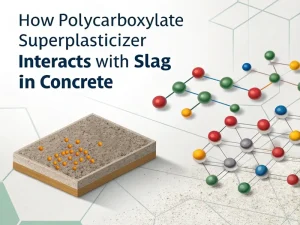Blog

Concrete is the most widely used building material globally, valued for its strength, durability, and versatility. Concrete admixtures are chemical substances added during mixing to improve workability, strength, and durability, they address challenges like adverse weather conditions, complex designs, and sustainability requirements.
Function: Disperse cement particles, reduce moisture content while maintaining slump, and maintain or even improve their workability.
Advantages: When the concrete slump is basically the same, it can reduce the mixing water consumption by more than 15% and increase the compressive strength by 20%.
Types: Currently, high-efficiency water reducers mainly include the naphthalene series, melamine series, and polycarboxylate saltwater reducers. Polycarboxylate series is the third generation of high-efficiency water reducers, with a water reduction rate of up to 45%.
For specific classifications, please refer to How Many Types of Superplasticizer>>
Function: Accelerate the hydration rate of cement and promote the development of early strength of concrete.
Advantages: In winter construction, adding drought-resistant agents can help concrete solidify faster and obtain strength, thereby reducing the risk of damage due to freezing. In emergency repair projects, such as road maintenance or the construction of prefabricated concrete components, it can shorten the construction time by 30-50% and help complete it within the deadline.
Types: Calcium chloride, sodium chloride, sodium sulfate, sodium carbonate, triethanolamine, etc.
Function: Delaying cement solidification, prolonging solidification time, generally does not affect concrete quality and can increase water reduction rate when used together with water-reducing agents
Advantages: Maintain long-term slump without segregation. High temperatures can cause concrete to set too quickly in hot weather, and retarders can delay the setting time. Retarders can also be used for large-scale concrete pouring, such as dams or large foundation slabs. Concrete must remain usable for these projects for an extended period to ensure proper pouring and consolidation.
Types: Commonly used include lignin, sugars, phosphates, tartrate, gluconate, citric acid and salts, cellulose and its derivatives, etc.
Function: Improve the flowability, cohesiveness, and water retention of concrete mixtures, enhance the flowability of concrete, and introduce microbubbles (3-7% volume) to resist freeze-thaw cycles.
Advantages: These bubbles play a role in buffering water expansion and contraction in concrete. When water freezes in the concrete pores, it expands, leading to cracking. Bubbles provide space for water expansion, reducing internal pressure and preventing damage. The bubble structure is good, with a small radius and a high frost resistance index. It is used for high-durability concrete structures, such as dams, high-grade highways, cooling towers for thermal power plants, water tanks, hydraulic engineering, ports, etc. In freeze-thaw environments, surface scaling and cracking are reduced by 50%.
Types: Rosin resins, alkyl and alkyl aromatic sulfonic acids, fatty alcohol sulfonic acid salts, saponins, protein salts, petroleum sulfonic acid salts, etc.
Function: An anti-seepage grade of P25 or above improves concrete’s anti-seepage and waterproof function. It also has the effects of slow setting, early strength, water reduction, crack resistance, etc. It can improve the workability of freshly mixed mortar.
Advantages: It prevents moisture infiltration and extends the service life of concrete buildings. By maintaining the same strength and slump as the benchmark concrete, 10% of cement can be saved.
Types: Ferric chloride, modified silicon, etc.
Function: Make concrete have good properties such as resistance to salt ion erosion, freeze-thaw cycle damage, and high permeability resistance
Advantages: Corrosion inhibitors can extend the lifespan of structures, reduce maintenance costs, and ensure public safety.
Steel corrosion may be a significant issue in structures with steel reinforcement, such as buildings, bridges, and parking lots. The addition of, corrosion inhibitors is a chemical substance that forms a protective film on the surface of steel bars, which can prevent corrosion and is used to protect the steel bars.
The optimal concrete admixture depends on various factors, including the project’s location, environmental conditions, ideal performance of the concrete, and construction progress. In many cases, a combination of additives can achieve optimal performance.
For example, high-strength concrete pouring for bridges in coastal areas may require a mixture of accelerators, high-efficiency water reducers, and air-entraining agents in cold weather. With the continuous development of the construction industry, research on new and improved additives will play a crucial role in improving the performance and durability of concrete structures.

How Polycarboxylate Polyether Monomer Affect Concrete Performance
Blog How Polycarboxylate

How Polycarboxylate Superplasticizer Interacts With Slag In Concrete
Blog How Polycarboxylate